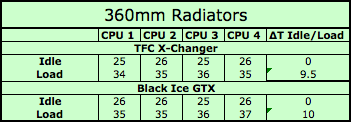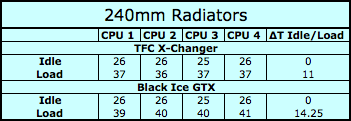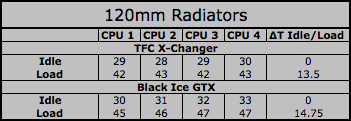Results
There's a lot to digest in this section, being as there's six different products trying to cover a myriad of price brackets. Initially, I was planning on running all four brands simultaneously, but decided to break it up to this round-up partially to make a more useful comparison.By keeping all other equipment equal, any differences should be attributable only to the radiators. Radiators particularly are non-linear in their effectiveness - under a certain percentage of total removable heat load will cause fairly equal performance due similar materials, regardless of construction quality (unless something's utterly broken.
Roughly translated, this means that if a system can dissipate 75W and 95W of heat respectively and you're only putting 25W of heat into it, both will cool similarly assuming equal flow. However, when you start dumping 65-70W of heat into the system, you'll find a sizeable difference in temperatures between the two.
In particular, I'm looking for changes in the delta between idle and load on the CPU, where the coolant is absorbing as much heat as it can from the block. The equilibrium temperature reached is going to depend on how much of that heat can be effectively removed from the system by the radiators.
So, let's take a look at the actual figures from the run:



First things first, let's look at the 120mm setups. There's a very clear difference in the performance here, with the Feser TFC X-Changer starting off at idle two degrees cooler. This is due to the better airflow and coolant flow, which is a big issue when you have so little space to work with. The system is a hair overloaded for a 120mm radiator, which you can see by the idle increases over all of the 240 and 360mm rads, and it starts to really show as things come under load.
At 240mm, both radiators start off at the same idle temperature - which means that there's no longer enough heat in the system for the radiators to be stressed at all. This is parroted by the fact that the 360mm idle temperatures do not go any lower. Once the load starts to increase on the CPU however, differences start to become apparent. The three to four degree difference between the cores shows that the TFC X-Changer is barely breaking a sweat, while the Black Ice GTX is starting to find its limits.
In the last set of 360mm, neither system shows too clear of a lead. Any difference above idle is attributable to the performance of the radiator, but the results speak unclearly. Given how well the TFC X-Changer has outpaced the Black Ice GTX in both other size classes, I think I might be hitting the limitations of my test bench. There's simply not enough heat to give either radiator much stress.
There's also some subjective (in this instance) testing - I can say quite assuredly that the Feser radiators ran more quietly than the Black Ice radiators. This is due entirely to fin surface area - the amount of fins on the Black Ice GTX create a "choppier" air delivery, which makes a distinct sound. This difference is subtle but clear enough that an outside (and unaware) observer was able to tell the difference without any understanding of what I was testing. Since the same fans were used for all tests, I can rule out most error.
Finally, we need to remember that many people run a larger radiator with a lower fan speed, and I would run out of space to include all of these variables. So, I've opted to run the radiators at their "max" cooling potential - a double-block loop, fans at full-speed, etc. It's important to note that running fans at 7v or otherwise modifying is not going to have a linear effect on the cooling potential.
Conclusion
Both the Black Ice GTX and the TFC X-Changer series of radiators are well designed, but it's clear that there's definitely a difference in performance for the price increase. Feser's performance starts off with a nice and cool two degree difference at idle on the 120mm radiator, and though the idle difference shrinks as the sizes increase as we'd expect, the temperature differences at load continues to increase.Looking at either extreme, we have cost vs. performance issues. The TFC X-Changer is almost 50 percent more expensive than the Black Ice at the 120mm level, but we start out two degrees cooler at idle. Granted, most people should not attempt to cool an 8800GTX and a Q66600 CPU on just a 120mm radiator, but it quickly sorts the wheat from the chaff - the TFC X-Changer wins hands down. At the moment it looks like you'll be paying quite heavily for that privilege - however, if you're looking at cooling a lot in a small space and you've already bought into watercooling, it'll be worth the investment without question.
The 360mm group shows much less differentiation for the same nearly 50 percent price increase, and my best guess for the performance is above in the results section. In order to get the most out of this type of setup with either instance, you're really going to need to look at why you need it - If you're not looking at 8800GTX SLI setups with a fairly well overclocked processor all in the same loop (in which case I ask, "Why?"), I doubt you'll be able to justify the price. The Feser 240mm cools almost as well as the Black Ice 360mm for less space and the same cost, and the Feser 360mm price is really hard to swallow without an incredibly good reason. Odds are that if you have a system to require this, you won't think twice about an additional $60 USD on your radiator cost anyhow.
It seems that the sweet spot for both radiators sits at the 240mm mark for price, where you seem to get the most bang for your cooling buck. In this, Feser clearly trumps the Black Ice by three solid degrees at load, which could be improved with a shroud or better fans. At this point, we're looking at a 35 percent price increase over the same sized Black Ice GTX ($134.99 vs. $99.99), but the difference at this point the narrowest margin while offering a better temperature spread versus the competition than the 360mm radiator.
I'm not entirely sure that price should be as much of an issue as I'm weighing it, as watercooling is not cheap by its very definition. However, I can't help but look forward to the TFC X-Changer getting a bit larger distribution volume so that the price comes down a hair relatively - the difference between $135 USD and $120 USD would be a tremendous increase in perceived value. At $135 it's a great performer at a "bleeding-edge" price, but $120 would make it pretty much impossible not to recommend.

TFC X-Changer 240mm

MSI MPG Velox 100R Chassis Review
October 14 2021 | 15:04









Want to comment? Please log in.